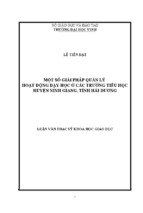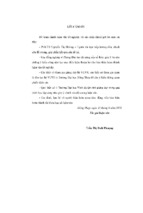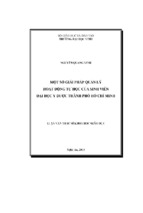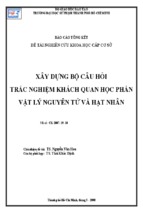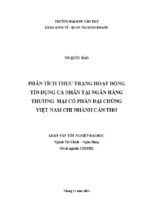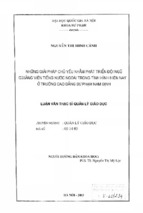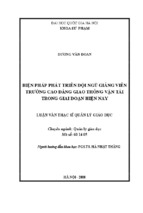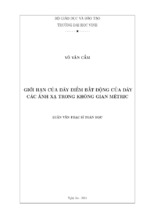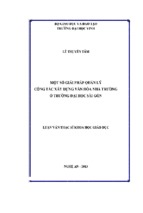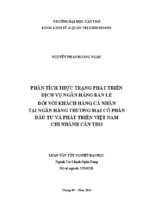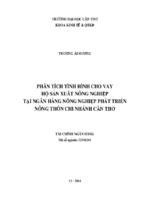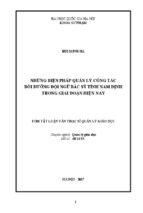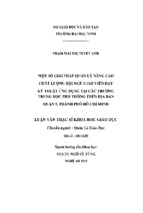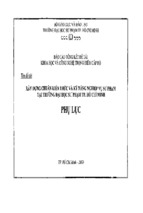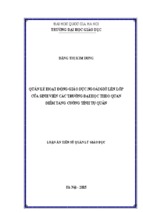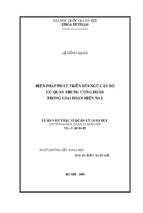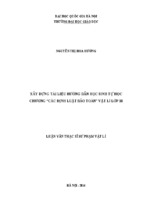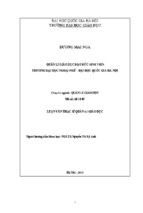1
2
MINISTRY OF EDUCATION AND TRAINING
The study has been completed at
UNIVERSITY OF DANANG
BÙI THỊ HOÀNG MAI
UNIVERSITY OF DANANG
Supervisor: Assoc. Prof. Dr. Lưu Quý Khương
Examiner 1:
AN INVESTIGATION INTO PROVERBS
WITH WORDS DENOTING HUMANS
Examiner 2:
IN ENGLISH AND VIETNAMESE
The thesis will be defended to the Examining Committee at the
University of Danang
Field
: THE ENGLISH LANGUAGE
Code
: 60.22.15
Time : September, 2011
Venue : Quang Trung University
MASTER THESIS IN THE ENGLISH LANGUAGE
(A SUMMARY)
Supervisor: Assoc. Prof. Dr. LƯU QUÝ KHƯƠNG
The thesis is accessible for the purpose of reference at:
•
•
Danang, 2011
The Library of College of Foreign Languages, University of
Danang
Information Resource Centre, University of Danang
1
Chapter 1
INTRODUCTION
1.1. RATIONALE
Natural language is not only a means of communication but
2
- enable them to receive natural language like proverbs
completely and sufficiently then apply them effectively in the process
of communication.
- solve the problem of loss and gain partly when translating
also a tool of expressing thoughts, feelings, emotions and desires of
this genre.
human beings. As a part of natural language, proverbs play an
1.3. AIMS AND OBJECTIVES
important role in cultural life of many communities. They were used
1.3.1. Aims
to diffuse not only life experience but also didactic lessons so they
- To examine the syntactic, semantic characteristics of English
should be included in any language study. It is really interesting to
proverbs containing words denoting humans (EPsWH) and
realize that ancient people use proverbs to highlight the organic
Vietnamese proverbs containing words denoting humans (VPsWH).
relationship between them and surrounding world. Human image
However, some stylistic devices in PsWH are also included in
figures in proverbs as lively subjects in the objective world and the
semantic section to clarify the sense relations of figurative proverbs
numbers of proverbs with words denoting humans occur as an
in natural language.
integral part in every language system. So they have become a
1.3.2. Objectives
linguistic phenomenon that linguistic researchers like us cannot
The study is planned to:
ignore. Moreover, in the globalization age, studying proverbs of a
- Investigate and describe syntactic and semantic features of
nation, especially proverbs contaqining words denoting humans
(PsWH) is one of the best ways to achieve the intercultural
communicative purpose effectively. For those reasons, I select “An
Investigation into Proverbs with Words Denoting Humans in
EPsWH and VPsWH
- Discover the similarities and differences between EPsWH
and VPsWH in terms of syntactic, semantic features.
- Suggest some implications in language learning, teaching and
English and Vietnamese” to study in the hope that I can gain a
translating proverbs of the two languages.
deeper insight into proverbs and their use in English and Vietnamese.
1.4. SCOPE OF THE STUDY
1.2. JUSTIFICATION
This research is of significance in linguistic practice. That is to
say that the study is intended to:
- help teachers and learners of English raise their socio-cultural
awareness of the country whose language they are utilizing.
This study is restricted to the syntactic and semantic features of
proverbs containing words denoting humans in English and
Vietnamese such as “Like father, like son”, “Yêu con ngon của” not
the proverbs “ Giậu ñổ bìm leo” or “Dumb folks get no land”(Trâu
chậm uống nước ñục) to point out the differences between the two
3
4
languages. The thesis is based on the viewpoint of Quirk [28],
classification of proverbs according to topics and explored their
Norrick [27] in English and Diệp Quang Ban [40] in Vietnamese.
occurrence in context. In addition, Collis [2] gave out 101 American-
1.5. RESEARCH QUESTIONS
English proverbs with a pithy overview about them. Nguyễn Đình
1) What are the syntactic and semantic features of EPsWH and
VPsWH?
Hùng [53] helped us distinguish proverbs and idioms, also presented
the syntactic features of English and Vietnamese Proverbs. Chu Văn
2) What are the similarities and differences between EPsWH
and VPsWH in terms of syntactic and semantic features?
3) What are the implications for teaching, learning and
Liên [58] listed English proverbs and their Vietnamese equivalence.
In Vietnamese, Chu Xuân Diên, Lương Văn Đang, Phuơng Tri
[46], Vũ Dung, Vũ Thuý Anh [47], Vũ Ngọc Phan [60] classified,
translating PsWH ?
compiled dictionaries or books of Vietnamese proverbs into different
1.6. ORGANIZATION OF THE STUDY
topics, gave brief comments on syntactic features of Vietnamese
Chapter 1: Introduction
proverbs. Nguyễn Lân [54] also gave out a lot of Vietnamese
Chapter 2: Literature Review
proverbs, their meaning explanation, and their usage in specific
Chapter 3: Research Methods and Procedures
situations. The matters relating to proverbs have been considered in
Chapter 4: Findings and Discussions
some master theses. Lê Thị Mỹ Nhật [16] investigated the
Chapter 5: Conclusions and Implications
metaphoric devices in English and Vietnamese animal proverbs. Lê
Chapter 2
Vân’s study was also involved in stylistic and cultural differences of
LITERATUR REVIEW AND
English and Vietnamese proverbs from human and animals’
THEORETICAL BACKGROUND
characteristics. Đặng Ngọc Cư [3] investigated parallelism in
2.1. LITERATURE REVIEW
In English, Taylor [36] focused on proverb definition,
metaphorical proverbs, proverbial types, variant proverbs in folk
proverbs. Trần Lê Nghi Trân [37] devoted herself to the Theme Rheme structure of English - Vietnamese animal proverbs.
2.2. THEORETICAL BACKGROUND
narratives, loan translation, classical or biblical origin of many
2.2.1. Overview of the Proverbs
proverbs. Ridoult and Whiting [30] collected eight hundreds English
In this part, I will illustrate some matters related to proverb
proverbs with their meaning. Norrick [27] introduced the semantic
definitions, proverb classification, characteristics of proverbs, proverbs
relations between proverbs. Freier [5] listed, gave representative
with human words.
samples of weather proverbs with reasons for why we should know
2.2.1.1. The Notions of Proverbs
them and how they work. Galperin [6] illustrated the periphery
There have been a large number of authors defining proverbs in
between proverbs and sayings. Mieder [21] presented the
one way or another such as the definitions in [9], [19], [21], [27],
6
5
[32], [36] in English and in [48], [50], [53] in Vietnamese. In this
- Permyakov (cited in [13, p.229]) built a system of proverb
study, we will use the definition in [9] and in [21] as working
classification based on three aspects: the linguistic aspect, the
definitions. Hornby [9, p. 1180] considers proverbs as “a well known
thematic aspect and logico-semiotic aspect.
phrase or sentence that gives advice or says something that is
2.2.2. Proverbs and Other Language Units
generally truth”. Besides, Mieder [21, p.5] defines “proverb is a
2.2.2.1. Proverbs and Idioms
short, generally known sentence of the folk which contains wisdom,
Proverbs and idioms share many common features as well as
truth, morals, and traditional views in a metaphorical, fixed and
memorizable form and which is handed down from generation to
the differences.
Table 2.3 Similarities and Differences between Proverbs and
generation”.
2.2.1.2. Proverbs with Words Denoting Humans
Proverbs that contain one or more words relating to or
SIMILARITIES
concerning people are regarded as PsWH.
Syntactic
2.2.1.3. Main Characteristics of Proverbs
a. The proverbs are realized as propositional statements.
DIFFERENCES
b. Pithiness.
c. The traditionality turns out to be a property of proverbs.
d. The didactic function.
2.2.2.2. Proverbs and Sayings
Table 2.4 Similarities and Differences between Proverbs and
e. Proverbs are also characterized by fixedness of form.
f. Poetic features or devices.
2.2.1.4. Classification of Proverbs
SIMILARITIES
- Matti Kuusi (cited in [21, p. 16-17]) classified proverbs on
the base of lexicographical categories.
- Milner (cited in [27, p.51-52]) offered proverb classification
system based on the semantic oppositions of proverbs by using
positive or negative values.
- Based on the semantic oppositions like Milner, Dundes (cited
in [27, p.56]) categorized proverbs into two main kinds: oppositional
and non-oppositional proverbs.
Semantic
Idioms
PROVERBS
IDIOMS
Ready-made linguistic units
Figurative meaning
Sentence
phrase
- judgment
- notion
- informative
- nominalization
- didactic
- figurative
DIFFERENCES
Sayings
PROVERBS
SAYINGS
- repeated sentences with rhythm
- independent units of communication
Syntactic - fixed form
- modified form
- popular statements by - well-known or
unknown author.
wise statements by
famous people.
- informing or denoting - denoting advice or
Semantic
a judgment
obvious truth
- experiential didactic
- observative
content or a rule of
statements without
didactic force
conduct
7
8
2.2.2.3. Proverbs and Clichés
Unlike an English verb phrase, a Vietnamese verb phrase
Table 2.5 Similarities and Differences between Proverbs and
Clichés
PROVERBS
Modifier(s) + Head + modifier(s)
CLICHÉS
c. Adjective Phrases
- easily remembered formulaic structures
SIMILARITIES
Adjective phrases in English consist of an adjective as head,
- figurative form
Syntactic
DIFFERENCES
includes a head verb and optional modifiers [40, p.63].
Semantic
optionally preceded and followed by modifying elements [28, p.63].
- brief sentence
- idea or phrase
- judgment
- notion
Pre-modification + Head + Post Modifier(s)
- informative
- naming
2.2.3.2. Sentences
- winning recognition - losing vigor
Sentences in both languages can be divided into:
through frequent use
through the frequent
- Simple Sentences:
- packing didactic
use
A sentence consisting of one subject-predicate structure is
lesson
- no didactic lesson
known as simple [40, p.113].
2.2.3. Overview of Structures of Proverbs
- Compound Sentences:
2.2.3.1. Phrases
A compound sentence consists of two or more subject-
a. Noun Phrases
predicate structures, each of them can work as a simple sentence [40,
According to Quirk et al. [28, p.62], noun phrases consist of a
p.113].
head, which is typically a noun and of elements which (either
- Complex Sentences:
obligatorily or optionally) determine the head and (optionally)
The sentence with two or more subject-predicate structures in
modify the head, or complement another element in the phrase. This
which one subject-predicate is included in the rest subject- predicate
view is also shared by Diep Quang Ban [40, p.24] in Vietnamese.
is a complex one [40, p.109].
b. Verb Phrases
Verb phrases consist of a main verb which either stands alone
Chapter 3
METHODS AND PROCEDURES
as the entire verb phrases or is preceded by up to four verbs in an
3.1. OVERVIEW
auxiliary function [28, p.62].
3.2. RESEARCH METHODS
Auxiliaries + Main Verb
The descriptive and contrastive analysis of EPsWH and
VPsWH was conducted so as to draw out some implications for the
9
10
teaching, learning and translating English proverbs and vice versa.
selected from bilingual dictionaries will be carefully checked up in
Besides, the quantitative and qualitative methods are concurrently
the monolingual dictionaries to make sure their origin.
Chapter 4
used.
FINDINGS AND DISCUSSIONS
3.3. SAMPLING
A corpus of 200 PsWH and 200 VPsWH was randomly
gathered from different sources such as bilingual or monolingual
4.1. OVERVIEW
4.2. SYNTACTIC FEATURES OF EPsWH AND VPsWH
dictionaries, books, encrypted both in print and on the internet
3.4. DATA COLLECTION
400 PsWH both languages have been arranged in the
The syntactic structures of PsWH in English and Vietnamese
are generalized in two levels from phrase structures to sentence
structures.
alphabetical order to be convenient in the study process.
4.2.1. Phrase Structures
3.5. DATA ANALYSIS
4.2.1.1. PsWH with Noun Phrase Structures
Noun Phrases of EPsWH and VPsWH can be generalized in
PsWH in English and Vietnamese are analyzed in terms of
syntactic and semantic features, then a comparison of PsWH in
table 4.1 as follows:
ENGLISH
3.6. INSTRUMENTATION
The monolingual and bilingual dictionaries of proverbs in two
languages are resorted to. Google search should be accounted
because a lot of relevant journals, newspapers, reference materials
have been taken thanks to this tool. Tables are also helpful for stating
NOUN PHARSES
English and Vietnamese is also is given.
VIETNAMESE
[1](Art) + Adj + N/ (Art) + Adj + N
[1] N + N / N + N
[2] Num + N/ Num + N
[2] N+ A /AP // Noun + Adj/AP
[3] N + N / N + N
[3] N + (nào) + N + (nấy)
[4] NP + prep + NP
[4] N + PP / N + PP
[5] NP + NP / NP + NP
the results of analysis and the percentage as well.
[6] Num +NP / Num + NP
3.7. RESEARCH PROCEDURES
[7] N + V/ N+ V
4.2.1.2. PsWH with Verb Phrase Structure
3.8. RELIABILITY AND VALIDITY
- In terms of reliability, the PsWH used for the analysis in this
dictionaries, novels, short stories, or journals. Especially, proverbs
PHRAS
In terms of validity, the samples of the study are taken from
VERB
books and websites.
table 4.2 as follows:
VVV
study, as mentioned above, are mainly collected from dictionaries,
Verb Phrases of EPsWH and VPsWH can be generalized in
ENGLISH
VIETNAMESE
[5] A + VP // A + VP
[8] V + N / NP // V + N / NP
[6] V + N /NP // V + N/NP
[9] V/VP + VP // V/VP + VP
11
12
[10] VP + A // VP + A
S + V as in Giặc ñến nhà, ñàn bà phải ñánh or S + V+ A// S + V +
[11] VP + V // VP + N
O as in Đời cha ăn mặn, ñời con khát nước.
4.2.2.3. Complex Sentences
[12] V + PP // V + N
In the process of investigating it is quite obvious that the
4.2.1.3. PsWH with Adjective Phrase Structure
complex pattern of EPsWH and VPsWH are quite different from
Verb Phrases of EPsWH and VPsWH can be generalized in
each other. The complex patterns of EPsWH turn out the compound
ENGLISH
PHRASES
ADJEC-TIVE
table 4.3 as follows:
patterns in Vietnamese.
VIETNAMESE
All sentence structures existing in EPsWH and VPsWH can be
[7] Adj + AP
[13] Adj + N // Adj + N
shown in table 4.4below:
[14] Adj + AP
Table 4.4 Sentence Structures of EPsWH and VPsWH
[15] Adj + VP// Adj + VP// Adj + VP
4.2.2. Sentential Structures
4.2.2.1. Simple Sentences
Simple sentence patterns in EPsWH are generally formed in all
seven basic clauses whereas simple sentence ones in VPsWH are
[17] S +V + C
(4.54) - Lúa ré là mẹ lúa chiêm.
[18] S + V + O
(4.57) - Gái dở thèm của chua.
4.2.2.2. Compound Sentences
In the corpus, both EPsWH and VPsWH own the structure of
compound sentences. Most of English proverbs of this kind are
formed in parallel form while Vietnamese structures occur in
symmetric structures.
In the process of examining, we also discover some proverbs
of compound pattern with unbalanced structures such as S +V + O //
SENTENCE STRUCTURES
framed in two structures:
ENGLISH
VIETNAMESE
Simple Patterns
Simple Patterns
[8] S+ V+ A
none
[9] S-V- C
[16] S +V + C
[10] S+ V+ O
[17] S + V + O
[11] S + V + O + A
none
[12] S + V + O + C
none
[13] S + V + O + O
none
[14] S +V
none
Compound Patterns
Compound Patterns
[15] S + V+O +(O) // S+V + O
[18] S+ V + O + (O) // S + V + O
[16] S + V + C // S+V + C
[19] S + V + C // S + V + C
none
[20]S + V+ A // S + V+ A
[17] S + V // S+V
[21] S +V // S +V
Complex patterns
Complex patterns
[18] S(S + V + O) + V + O
none
[19] Sub + S + V // S + V
none
13
14
- Both EPsWH and VPsWH own the patterns in forms of noun
[20] Sub + S + V // S + V + C
none
none
[22] S[S+V+O] + C.m + V[S + V + O]
phrases, verb phrase and adjective phrases. They both have similar
none
[23] S [S +V + A] + C.m + V[S+V+ A]
structures such as N+N / N+N, V + N/NP // V + N/NP, Adj + AdvP.
none
[24] S [S +V] + C.m + V[S +V]
- Parallel structures, elliptical structures, and comparative
structures are frequently used by the English and Vietnamese such as
Table 4.6 A Statistical Summary of Syntactic Features of
Ở chọn nơi, chơi chọn bạn; Đàn ông như giỏ, ñàn bà như hom in
EPsWH and VPsWH
Vietnamese and A good husband makes a good wife; Many women,
English and Vietnamese Proverbs
with Words Denoting Humans
Structures
Syntactical Analysis
Phrase
Noun Phrase
ENGLISH
VIETNAMESE
many words in English.
- EPsWH and VPsWH own a set of metaphorical descriptive
Number
22
%
11.0
Number
%
36
18.00
structures as in A bad workman quarrels with his tools or Đời cha
trồng cây, ñời con hái quả.
- Both English and Vietnamese have many variants proverbs.
Verb Phrase
4
2.00
32
16.00
This reveals that the fixedness of proverbs in both languages is relative.
4.2.3.2. Differences
Adjective Phrase
2
1.00
10
5.00
- In the corpus, VPsWH in the form of verb phrases are much
Sentence Structures
more than EPsWH of the same form in number.
Simple Sentence
141
70.5
27
13.50
- The number of EPsWH as simple sentences is more
considerable than the one in Vietnamese.
Compound
Sentence
Complex
Sentence
Total
19
9.50
62
31.00
EPsWH.
12
6.00
33
16.50
4.2.3.1. Similarities
- VPsWH exhibit the symmetrical structure in form or
quadripartite structure. Many proverbs with four elements in their
200
100
200
100
4.2.3. The Syntactic Similarities and Differences of EPsWH
and VPsWH
- The parallel construction is more numerous in VPsWH than
surface structure were found such as Mẹ ăn, con giả (trả), In
contrast, the quadripartite structure of EPsWH are not popular.
- Prosodic feature tend to be used more frequently by the
Vietnamese people than the English one.
4.3. SEMANTIC FEATURES OF EPsWH
4.3.1. Semantic Fields of EPsWH and VPsWH
15
16
4.3.1.1. Humans and Labour
4.3.1.2. Humans and Life Experience
4.3.1.3. Humans and Weather
4.3.1.4. Humans and Health
4.3.1.5. Humans and Family Relationship
4.3.1.6. Humans and Social Relationship
4.3.1.7. Humans and Profession –Business
4.3.1.8. Humans and Marriage
4.3.1.9. Humans and Destiny
4.3.1.10. Humans and Psychological States
4.3.1.11. Humans and Characters
4.3.1.12. Humans and Education
4.3.1.13. Humans and Physical Appearance
4.3.1.14. Humans and Customs
4.3.1.15. Humans and Belief
4.3.1.16. Humans and Virginity
4.3.1.17. Humans and Situations
Relationship
Humans and
7
SEMANTIC FIELDS
Vietnamese
2.00
9
4.50
25
12.50
Humans and Education
6
3.00
11
5.50
11
Humans and Physical
7
3.50
14
7.00
1
0.50
12
6.00
0
0
29
14.50
0
0
5
2.50
15
7.50
Humans and
13
Humans and Marriage
14
Humans and
15
Humans and Custom
0
0
9
4.50
16
Humans and Belief
0
0
8
4.00
%
17
Humans and Virginity
0
0
5
2.50
18
Others
44
22.00
9
4.50
111.0
225/200
112.5
3.00
6
3.00
76
38.00
30
15.00
3
1.50
3
1.50
15
7.50
26
13.00
28
14.00
12
6.00
Humans and Social
4
Number
6
6
6.50
%
Humans and Weather
Relationship
13
Number
2
Humans and Family
10
Circumstance
4.50
5
1.50
States
9
Humans and Medicine
Humans and
Psychological
3.00
4
9
12
6
Experience
Humans and Destiny
Appearance
Humans and Labour
Humans and Life
8
Characters
1
3
3
Business
Table 4.8 Frequency of Semantic Fields of EPsWH and VPsWH
English
Profession-
TOTAL
224/ 200
4.3.2. Stylistic Devices of EPsWH and VPsWH
4.3.2.1. Simile
In English simile can be recognized via connective words such
as “like”, “as”, “such as”, “as if”, “seem”, “than”. In Vietnamese,
comparative markers (c.m) are introduced by the words “như”,
“bằng”, “hệt”, “tựa”, “giống như”, “tày”…
18
17
General comparative structure: A c.m B. However, in EPsWH
form of a lexical item, quantifier or number from too high on some
A does not always appear.
scale within the appropriate category.
(4.157) - Drunk as a beggar.
(4.170)- A woman’s work is never done.
4.3.2.2. Antithesis
(4.171)- One father can support ten children, ten children cannot
Characteristic of antithesis in proverbs is that antithesis is
generally formed by the pairs of objective antonyms in parallel form.
support one father.
Table 4.9 Frequency of Stylistic Devices in EPsWH and VPsWH
(4.162)- A miserly father makes a prodigal son.
(Cha hà tiện, con hoang phí)
4.3.2.3. Metaphor
Metaphor is a useful means of creating figurative images so
English and Vietnamese people prefer using it in proverbs to other
stylistic devices.
(4.167)- A wife is the key to the house.
(Vợ là tay hòm tay khóa)
(4.168)- A burnt child dreads the fire.
English
Vietnamese
STYLISTIC DEVICES
Number
Percent
Number
Percent
1
Simile
7
3.50
29
14.50
2
Antithesis
10
5.00
24
12.00
3
Metaphor
177
88.50
136
68.00
4
Metonymy
2
1.00
0
0
5
Hyperbole
4
2.00
11
5.50
200
100
200
100
Total
(Con chim phải ná sợ cành cây cong)
4.3.2.4. Metonymy
Galperin [6, p.144] states that metonymy is based on a type of
relation between the dictionary and contextual meaning, a relation
based not on identification, but on some kinds of association
connecting the two concepts which these meanings present.
(4.169)- One tongue is enough for a woman.
In English we have only two proverbs of metonymy. This
stylistic device is not even used in the corpus of VPsWH.
4.3.2.5. Hyperbole
The use of hyperbole, therefore, is considered as a form of
amplification. In the proverbs exaggeration is often moulded in the
4.3.3. The Semantic Similarities and Differences of EPsWH
and VPsWH
4.3.3.1. Similarities
- English and Vietnamese own a large number of PsWH in
their national treasure of folklore. These proverbs, in some way, not
only provide us with a valuable bag of wisdom but also broaden our
awareness of cultural value, life experience.
- PsWH in the two languages is also marked by the use of
many similar stylistic devices such as metaphor, antithesis,
hyperbole, and simile.
- The phenomenon of the twofold application of meaning in
most EPsWH and VPsWH: the surface meaning of the proverbs and
19
20
their figurative meaning embodied through the stylistic markers as
Chapter 5
mentioned.
- Identical semantic feature between EPsWH and VPsWH is
CONCLUSIONS AND IMPLICATIONS
5.1. OVERVIEW
that they both share the same eleven semantic fields: humans and
In the final part of the thesis I would like to review the results
labour, humans and weather, humans and life experience, humans
of the study then draw some conclusions from the detailed analysis
and medicine, humans and family relationship, humans and social
of the previous chapter and offer some implications for future
relationship, humans and profession-business, humans and destiny,
research on proverbs and related genres.
humans and psychological states, humans and characters, humans
5.2. CONCLUSIONS
and education.
As mentioned in the first chapter, this thesis is aimed to deal
- English and Vietnamese people meet each other in thought in
with the syntactic and semantic features of PsWH in English and
spite of the fact that they live far from each other. As a matter of fact,
Vietnamese. Through the detailed analysis and description of
the formation as well as the way they generalize their idea in
examples, many matters relating to grammatical structures as well as
proverbs are identical.
meaning transfer owned by PsWH can be generalized as follows.
4.3.3.2. Differences
Syntactically, EPsWH in the two languages are formed either
- Although both English and Vietnamese people like to use
in the phrasal structures or in sentence structures. The phrase
stylistic devices in their proverbs to make their utterance more
structures in EPsWH and VPsWH are classified into noun phrases,
condensed and colourful, the frequency of these expressive means
verb phrases, and adjective phrases. Sentential structures are also
does not always occur in correspondence because of different habit of
categorized in simple, compound and complex sentences. In the
language use in the two nations.
collected corpus, the number of proverbs in noun phrase form in both
- The dissimilarities between cultural characteristics of the two
languages is more popular than the other phrases. However, in the
nations impose on thought of people there. As a result, this produces
form of sentence, simple sentences tend to occupy the largest number
different proverbs of different semantic field as an inevitable
in the total of EPsWH and these simple ones distribute in seven
consequence.
different patterns while in VPsWH there are three kinds of pattern
- Another reason causes the differences in EPsWH and VPsWH
frequently used. The symmetric structures of proverbs with four
may be originated from the circumstances, environment, economic
words in each half are used more popularly in VPsWH than in
condition, social context people are coming in for. Different
EPsWH. Thus it is easy for us to see the proverbs like these: Cha ñưa
awareness leads to the difference in describing objects or
mẹ ñón; Mẹ ăn con trả. However, the proverbs with four words in
phenomenon in the objective world.
EPsWH are less frequently used than the ones in Vietnamese.
21
22
Semantically, there are total of 17 groups of semantic fields in
interlingual errors are originated from the deficiency of cultural
both languages categorized. Through the process of investigation we
knowledge. The best way to solve it is to supply our students with
have also discovered that most proverbs contain two simultaneous
background knowledge of history, culture, traditions, customs,
meaning at the same time: literal meaning and figurative meaning, so
related to proverbs in general and EPsWH in particular. Once the
we sometimes find it difficult to understand the proverbs at the first
learners understand the context in which EPsWH exist, their
sight. Basically, the figurative meaning or implied meaning of
language acquisition will be raised considerably. In the case of
proverbs is usually conveyed through the expressive means such as
EPsWH or VPsWH, there is no exception.
metaphor, metonymy, hyperbole, simile, or metaphor. More
Another interesting thing getting our attention is that there
interesting, some Vietnamese proverbs have no equivalence in
always exist the various layers of meanings in most EPsWH and
English or vice versa because of the cultural differences from
VPsWH. Thus, a clear explanation of the meaning transfer should be
countries to countries.
given to make our students feel the hidden beauty of the proverbs.
5.3. IMPLICATIONS
This profound understanding will get the learners to be involved in
No doubt proverbs are an indispensable part of any language
learning actively and enthusiastically.
system. One, therefore, should be equipped with the knowledge of
Remembering a set of various proverbs is not always an easy
proverbs so that he can be active in the communication process.
task for many students. To eliminate this limitation teacher should
However, in many cases, the figurative meaning of proverbs can be
categorize PsWH in sub-groups according to topics so that the
differently interpreted from their literal reading. So it is necessary for
students can take advantage of connecting similar lexical units in the
English teachers to foresee the language barriers their students often
process of memorizing and they can remember PsWH more easily.
confront when they acquire foreign languages in general as well as
From the contrastive analysis of PsWH in the two languages in
proverbs in particular. Then these teachers can help the learners with
chapter 4, it can be seen that some EPsWH and VPsWH share the
effective ways of learning proverbs. For example, to control students’
similarities of structures or semantics. For instance, English people
feeling of hesitation to use proverbs, teachers should get them to be
say “Like father, like son”, the Vietnamese use “Cha nào, con nấy”.
gradually familiar with proverbs. The subtle transmission of the most
Clearly,
frequently used proverbs in teaching process day by day can be
equivalences in their proverb treasures. Therefore, discovering and
served as an effective method to improve this.
using suitable equivalences in the inventory is the best way to have a
both
English
and
Vietnamese
have
corresponding
Also, the English teachers like us should not ignore cultural
perfect translation. This is to say that a translator must have a
gaps between source language and the target language because
profound knowledge of the target language and the source language
23
24
so that the content and the form of proverbs can be exactly and
meanings possessed by PsWH yet. For the reasons given above, some
naturally interpreted.
suggestions for further studies should be carried out to reveal
However, there are not always absolute equivalences. Many
practical uses of proverbs:
proverbs with words denoting humans in English have equivalences
� An Investigation into Pragmatic and Cultural Aspects of
without words denoting humans in Vietnamese or vice versa. The
Proverbs Containing Words Denoting Humans in English and
English proverbs “A man cannot spin and reel at the same time” or
Vietnamese.
“A hungry man, an angry man”, which are equivalent to “Xay lúa thì
� An Investigation into Syntactic and Semantic Features of
khỏi bồng em” or “Đói ăn vụng túng làm càn” in Vietnamese are
Proverbs Containing Words Denoting Female in English and
typical examples for this. In Vietnamese equivalences, no words
Vietnamese.
denoting humans can be found. In these cases, it is advisable for the
translators to transform the structures of proverbs to make the content
be remained. On the other hand, one must identify the implied
meaning of proverbs to select proper equivalences. In case of not
finding any synonymous as the translators desire, they should render
the true meaning of the original proverb. In other words, literal
translation should be favored in this case.
One more point of great importance is that while translating
proverbs, one should not isolate them from cultural context because
any forms of language, including proverbs are affected by cultural
factors such as norms, customs, prejudices, notions, belief. A
harmonious combination between language context and cultural
context is the key to success in translating proverbs in general.
5.4. LIMITATIONS AND SUGGESTIONS FOR FURTHER
RESEARCH
It is obvious to see that this study cannot cover all aspects of
PsWH due to time constraint, limitation of materials. Here in this
thesis we have centered on PsWH. However, not all PsWH are
included and we have never touched upon all the structures and
- Xem thêm -

